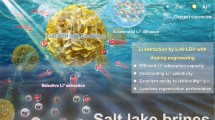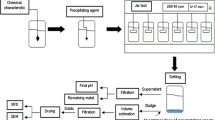Abstract
Chelating agents were used recently to stimulate sandstone formations in oil and gas reservoirs. Chelating agents replaced the old sandstone acidizing fluids such as mud acid (HF \(+\) HCl). Mud acid has several problems such as high corrosion rate, reservoir unconsolidation problems, and incompatibility with the reservoir rocks. The objective of this study is to introduce different chelating agents diluted in deionized water and seawater combined with potassium carbonate as a catalyst and clay stabilizer to stimulate sandstones reservoirs. In this paper, solubility experiments were performed for Bandera and Berea sandstone rocks in high pH DTPA, ethylenediaminetetraacetic acid (EDTA), and hydroxyethylenediaminetriacetic acid (HEDTA) solutions. The optimum concentrations of both chelating agent and potassium carbonate were determined through the solubility experiments. Chelating agents were diluted using seawater and deionized water from an initial concentration of 40 wt%. Coreflooding experiments were performed on Berea and Bandera sandstone cores to assess the performance of the new formulation. Corrosion tests were conducted on actual tubing coupons made of L-80 alloy to check the corrosion rate of the new formulations. The enhancement in the core permeability was recorded after using the chelating agent and the catalyst to investigate the effectiveness of the formulation in sandstone acidizing. The solubility results showed Berea and Bandera sandstone have good solubility in HEDTA, EDTA, and DTPA chelating agents. EDTA chelating agent combined with potassium carbonate enhanced the permeability of both sandstone cores. EDTA chelating agent combined with catalyst has a corrosion rate of \(0.01\,\hbox {lbm/ft}^{2}\) at \(350\,^{\circ }\hbox {C}\) compared to \(0.65\,\hbox {lbm/ft}^{2}\) for the mud acid plus 3 vol% corrosion inhibitor at the same temperature. The corrosion inhibitor additives will be eliminated in the new formulation which will reduce the cost of the stimulation fluid.
Similar content being viewed by others
References
Thomas, R.L.; Nasr-El-Din, H.A.; Lynn, J.D.; Mehta, S.; Zaidi, S.R.; Precipitation during the acidizing of a HT/HP illitic sandstone reservoir in Eastern Saudi Arabia: a laboratory study. Paper SPE 71690 presented at the Annual Technical Conference and, New Orleans, Louisiana, 30 Sept–3 Oct 2001
Simon, D.E.; Anderson, M.S.; Stability of clay minerals in acid. Paper SPE 19422 presented at the SPE Formation Damage Control Symposium, Lafayette, Louisiana, USA, 22–23 Feb 1990
Labrid, J.C.: Thermodynamic and kinetic aspects of argillaceous sandstone acidizing. SPE J. 15(2), 117–128 (1975)
Ali, A.H.A.; Frenier, W.; Xiao, Z.; Ziauddin, M.; Chelating agent-based fluids for optimal stimulation of high-temperature wells. Paper SPE 77366 presented at the SPE Annual Technical Conference and Exhibition, San Antonio, Texas, 29 Sept–2 Oct 2002
Al-Shaalan, T.M.; Nasr-EI-Din, H.A.; Modeling, mathematical of sandstone stimulation: a critical review of available models. Paper NACE-00443 presented at Corrosion 2000, Orlando, Florida, 26–31 Mar 2000
Mahmoud, M.A.; Nasr-El-Din, H.A.; De Wolf, C.A.: High-temperature laboratory testing of illitic sandstone outcrop cores with HCl-alternative fluids. SPE Prod. Oper. J. 30(1), 43–51 (2015)
Gdanski, R.; Kinetics of the primary reaction of HF on alumino-silicate. Paper SPE 37459 presented at the SPE Production Operations Symposium, Oklahoma City, USA, 9–11 Mar 1997
Kunze, K.R.; Shaughnessy, C.M.: Acidizing sandstone formations with fluoboric acid. SPE J. 23(1), 65–72 (1983)
Jaramillo, O.J.; Romero, R.; Ortega, A.; Milne, A.; Lastre, M.; Matrix acid systems for formations with high clay content. Paper SPE 126719 presented in the SPE International Symposium and Exhibition on Formation Damage Control, Lafayette, Louisiana, USA, 10–12 Feb 2010
Al-Anazi, H.A.; Nasr-El-Din, H.A.; Hashem, M.K.; Hopkins, J.K.; Matrix acidizing of water injectors in a sandstone field in Saudi Arabia: a case study. Paper SPE 62825 presented in the SPE/AAPG Western Regional Meeting, California, USA, 19–22 June 2000
Shafiq, M.U.; Shuker, M.T.; Finding suitable acid for acidizing of low permeable sandstone formation: a research. Paper SPE 169641 presented at the SPE/PAPG Annual Technical Conference, Islamabad, Pakistan, 26–27 Nov 2013
Yang, F.; Nasr-El-Din, H.A.; AL-Harbi, B.; acidizing sandstone reservoirs using HF and formic acids. Paper SPE 150899 presented at the SPE International Symposium and Exhibition on Formation Damage Control, Lafayette, Louisiana, USA, 15–17 Feb 2012
Al-Harbi, B.G.; Al-Dahlan, M.N.; Al-Khaldi, M.H.; Al-Harith, M.A.; Abadi, A.K.; Evaluation of organic-hydrofluoric acid mixtures for sandstone acidizing. Paper IPTC 16967 presented at the International Petroleum Technical Conference, Beijing, China, 26–28 Mar 2013
Al-Harbi, B.G.; Al-Dahlan; Al-Khaldi M.N.; Aluminum and iron precipitation during sandstone acidizing organic-HF acids. Paper SPE 151781 presented at the SPE International Symposium and Exhibition on Formation Damage Control, Lafayette, Louisiana, USA, 15–17 Feb 2012
Fredd, C.N.; Fogler, H.S.; Chelating agents as effective matrix stimulation fluids for carbonate formations. Paper SPE 37212 presented at the SPE International Symposium on Oil Field Chemistry, Houston, Texas, USA, 18–21 Feb 1997
Fernier, W.W.; Wilson, D.; Crump, D.; Jones, L.; Use of highly acid-soluble chelating agents in well stimulation services. In: Proceeding of the SPE Annual Technical Conference and Exhibition, SPE 63242, Dallas, Texas, USA, Oct 2000
Reyes, E.A.; Smith, A.L.; Beaturbaugh, A.; Properties and applications of an alternative aminopolycarboxylic acid for acidizing sandstones and carbonates. Paper SPE 165142 presented at SPE European Formation Damage Conference & Exhibition, Noordwijk, Netherlands, 5–7 June 2013
Sokhanvarian, K.; Nasr-El-Din, H.A.; Wang, G.; De Wolf, C.A.; Thermal stability of various chelates that are used in the oilfield and potential damage due to their decomposition products. Paper SPE 157426 presented at the SPE international Production and Operations Conference and Exhibition, Doha, Qatar, 14–16 May 2014
Al Dahlan, M.N.; Al-Harbi, B.G.; Al-Khaldi, M.H.; Evaluation of chelating-hydrofluoric systems. Paper IPTC 16969 presented at the International Petroleum Technology Conference, Beijing, China, 26–28 Mar 2013
Li, N.; Zhang, Q.; Wang, Y.; Liu, P.; Zhao, L.: A new multichelating acid system for high-temperature sandstone reservoirs. J. Chem. 2015, 594913 (2015). https://doi.org/10.1155/2015/594913
Parkinson, M.; Munk, T.; Brookley, J.; Caetano, A.; Albuquerque, M.; Cohen, D.; Reekie, M.; Stimulation of multilayered-carbonate-content sandstone formations in West Africa using chelant-based fluids and mechanical diversion. Paper SPE 128043 presented at the SPE International Symposium and Exhibition on Formation Damage, Lafayette, Louisiana, 10–12 Feb 2010
Nasr-El-Din, H.A.; Dana, H.; Tomos, V.; Stanitzik, T.; De Wolf, C.A.; Alex, A.; Field treatment to stimulate an oil well in an offshore sandstone reservoir using a novel, low corrosive, environmentally friendly fluid. Paper SPE 168163 presented at the SPE International Symposium and Exhibition on Formation Damage Control, Lafayette, Louisiana, USA, 26–28 Feb 2014
De Wolf, C.A.; Bang, E.; Bouwman, A.; Braun, W.; De Oliveira, E.; Nasr-El-Din, H.A.; Evaluation of environmentally friendly chelating agents for application in oil and gas industry. Paper SPE 168145 presented at the International Symposium and Exhibition on Formation Damage Control held in Lafayette, Louisiana, USA, 26–28 Feb 2014
Civan, F.: Reservoir Formation Damage, 3rd edn. Gulf Publishing Company, Houston (2015)
Al-Mutairi, S.H.; Nasr-El-Din, H.A.; Aldriweesh, S.M.; Al-Muntasheri, G.A.; Corrosion control during acid fracturing of deep gas wells: lab studies and field cases. Paper SPE SPE-94639 presented at the SPE International Symposium on Oilfield Corrosion, Aberdeen, United Kingdom, 13 May 2005
Kalfayan, L.: Production Enhancement with Acid Stimulation. PennWell Corporation, Tulsa (2008)
Mahmoud, M.A.; Nasr-El-Din, H.A.; Wolf, C.A.; LePage, J.N.; Stimulation of carbonate reservoirs using GLDA (chelating agent) solutions. Paper SPE 132286 presented at the SPE Trinidad and Tobago Energy Resources Conference, Port of Spain, Trinidad, 27–30 June 2010
Mostofizadeh, B.; Economides, M.J.; Optimum injection rate from radial acidizing experiments. Paper SPE 28547 presented at the SPE Annual Technical Conference and Exhibition, New Orleans, Louisiana, 25–28 Sept 1994
Based on Personal Communication with the Field Engineers
Acknowledgements
The author would like to acknowledge the support provided by King Abdulaziz City for Science and Technology (KACST) through the Science & Technology Unit at King Fahd University of Petroleum & Minerals (KFUPM) for funding this work through Project No. NSTIP-13-Oil-151-04 as part of the National Science, Technology, and Innovation Plan.
Author information
Authors and Affiliations
Corresponding author
Rights and permissions
About this article
Cite this article
Mahmoud, M. Reaction of Chelating Agents and Catalyst with Sandstone Minerals During Matrix Acid Treatment. Arab J Sci Eng 43, 5745–5756 (2018). https://doi.org/10.1007/s13369-017-2962-8
Received:
Accepted:
Published:
Issue Date:
DOI: https://doi.org/10.1007/s13369-017-2962-8




